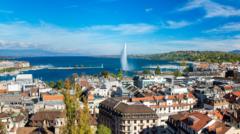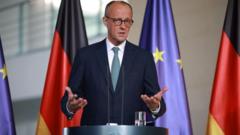Spain has become one of Europe's leading economies post-COVID, showcasing a robust tourism sector and targeted investments that have led to substantial GDP growth, while addressing employment and energy issues amidst looming challenges.
Spain's Economic Resurgence: A Model for Europe

Spain's Economic Resurgence: A Model for Europe
Despite pandemic challenges, Spain's economy is thriving, driven by tourism and strategic investments.
On a cold winter afternoon in Segovia, central Spain, the iconic Roman aqueduct draws both local and international tourists, illustrating the ongoing allure of the Spanish cultural and historical landscape. Many visitors, captivated by the city's charm, underscore the resilience of Spain's economy as it bounces back from the pandemic's grip. According to local tour guide Elena Mirón, the tourism sector has rebounded strongly, with hopes for continued growth in 2023 and 2024.
In 2024, Spain welcomed a record 94 million visitors, positioning itself just behind France in the global tourism race. This resurgence is key to Spain's impressive post-pandemic GDP growth of 3.2%, in stark contrast to declining economies such as Germany and France. The Economist magazine recently highlighted Spain as the world's top-performing economy, attributing this success to a balanced economic model that fosters sustainable growth.
Carlos Cuerpo, Spain's business minister, emphasized the multifaceted economic recovery stemming from diverse sectors, including tourism, financial services, and technology. Significant support comes from the EU's Next Generation recovery funds, which Spain plans to leverage to enhance infrastructure and sustainability, anticipated to total €163 billion by 2026. This strategic investment is crucial for modernizing the economy and improving growth potential.
While public spending has spurred growth, other major European economies show slower progress, hampered by dependence on industries facing multiple global challenges. Spain's comparatively stable economic environment is underscored by effective government interventions that mitigated inflation and energy price surges, particularly during the energy crisis linked to the war in Ukraine. Spanish authorities implemented targeted subsidies and negotiated energy price caps with the EU to alleviate consumer burdens.
A burgeoning renewable energy sector further enhances Spain's economic landscape, bolstering corporate investment and supporting the electric vehicle industry. However, a significant challenge remains the enduring unemployment rate, historically the highest within the EU. Furthermore, although jobless rates dipped to 10.6% in late 2024, a systemic labour reform aimed at enhancing employment stability is now needed.
Despite the progress, future concerns linger: there are voices within Spain addressing the dependency on tourism, rising public debt levels, and an escalating housing crisis. The minority government led by Socialist Prime Minister Pedro Sánchez faces an intricate web of political pressures, influencing responses to urgent economic challenges.
Moreover, immigration remains a contentious topic, but many economists argue that integrating migrants into the labour market may be essential for Spain's aging population and economic sustainability. While Spain is poised to continue leading growth among major EU economies, navigating political polarization and societal demand for balance will be crucial in shaping a more stable economic future.




















